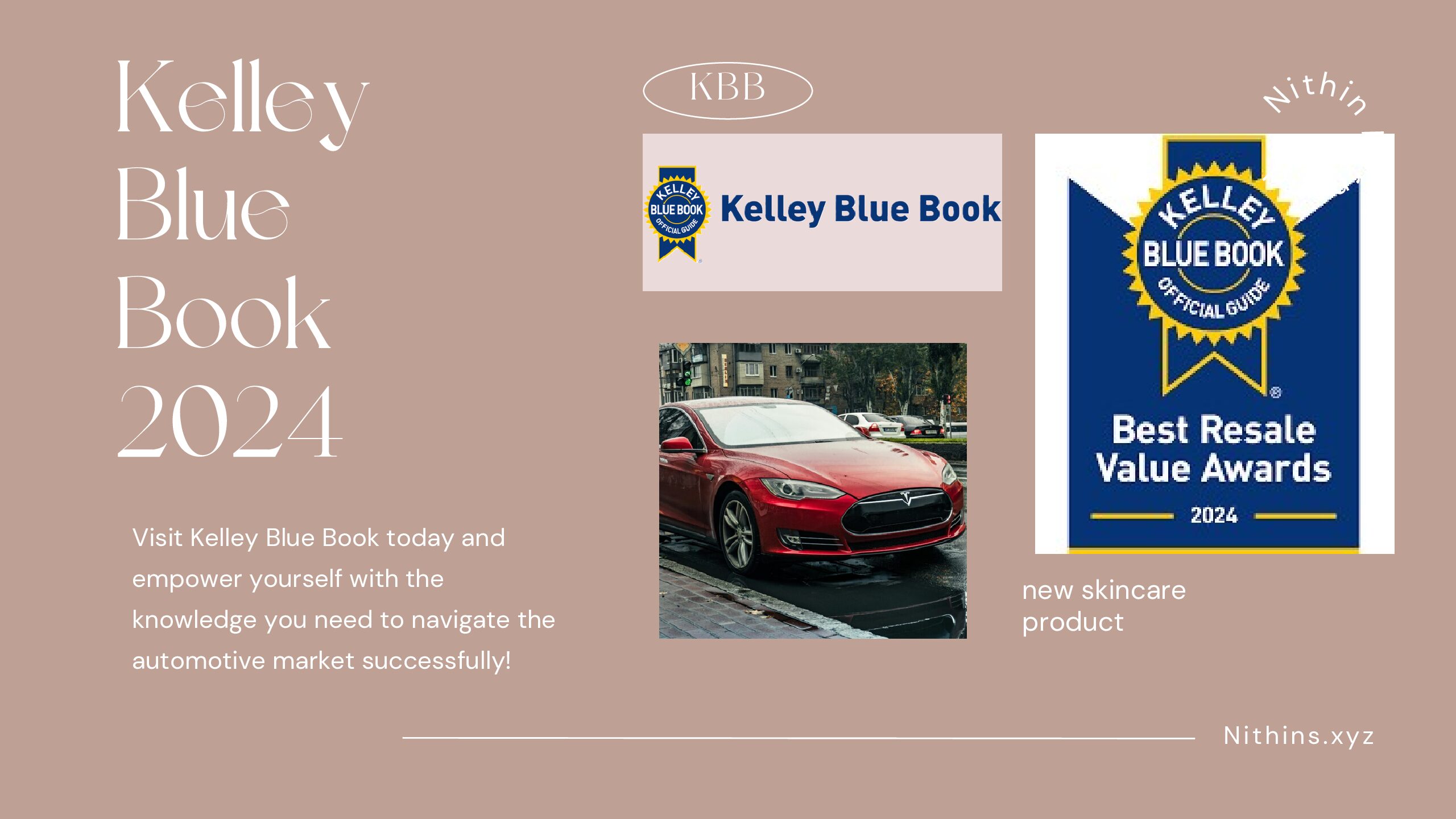Kelley Blue Book 2024
In the complex world of buying and selling cars, having reliable information can make all the difference. Kelley Blue Book (KBB) has established itself as a cornerstone in the automotive marketplace, providing invaluable data to consumers, dealerships, and industry professionals alike. Founded in 1926, KBB has transformed from a simple guidebook into a comprehensive online resource, renowned for its vehicle valuation and automotive research tools.
In the complex world of buying and selling cars, having reliable information can make all the difference. Kelley Blue Book (KBB) has established itself as a cornerstone in the automotive marketplace, providing invaluable data to consumers, dealerships, and industry professionals alike. Founded in 1926, KBB has transformed from a simple guidebook into a comprehensive online resource, renowned for its vehicle valuation and automotive research tools.
The importance of Kelley Blue Book cannot be overstated. It serves as a trusted reference point for determining fair market values, allowing buyers and sellers to make informed decisions. Whether you’re trading in your vehicle, purchasing a new car, or simply exploring the market, KBB’s insights help you understand the worth of your investment in an ever-changing automotive landscape.

The purpose of this article is to delve into the history, features, and significance of Kelley Blue Book in today’s automotive industry. We will explore how KBB operates, what tools it offers to consumers, and its role in shaping automotive values. Through this examination, we aim to highlight why Kelley Blue Book remains an essential resource for anyone involved in the car buying or selling process.
Table of Contents
History of Kelley Blue Book
Founding and Early Years
Kelley Blue Book was founded in 1926 by Les Kelley, a California-based automobile dealer. Initially, the company began as a simple printed guide that offered pricing information on used cars, helping individuals to better understand the value of vehicles in a time when the automotive market was just beginning to take shape. The guide was a straightforward yet revolutionary concept at that time, as it provided a reliable reference for dealers and consumers alike, allowing for more equitable transactions.
The name “Blue Book” stems from a tradition in academia where the color blue was associated with privileged knowledge and authoritative sources. The company aimed to establish itself as a trustworthy source of automotive values, positioning itself as the definitive guide for car prices.
Evolution of the Business Model
Over the decades, Kelley Blue Book transitioned from a printed publication to a more diversified business model. In the 1970s, with the advent of technology and increasing consumer demand for data, KBB expanded its offerings, moving towards more systematic methods of vehicle valuation. This included compiling extensive market research, examining sales data, and analyzing vehicle performance metrics to derive accurate pricing.
The growth of the internet in the 1990s marked a significant turning point for Kelley Blue Book. Embracing the digital revolution, KBB launched its website in 1995, making its valuation tools more accessible to consumers and dealers. This online transition democratized information and allowed users to instantly access vehicle pricing, reviews, and other essential automotive data.
Key Milestones in the Company’s History
- 1926: Les Kelley publishes the first edition of the Kelley Blue Book, establishing a standard for used car pricing.
- 1970s: KBB begins to expand its pricing methodology, incorporating data analysis to improve valuation accuracy.
- 1995: The launch of the Kelley Blue Book website signals a shift to online resources, making vehicle valuations widely accessible.
- 2000: KBB introduces the concept of “Consumer Ratings,” allowing users to leave feedback and experiences about various vehicles, adding an important dimension to their offerings.
- 2006: KBB implements the “Fair Purchase Price” tool, helping consumers understand what others are paying for specific vehicles in their area.
- 2010s: Kelley Blue Book evolves to meet the needs of a changing automotive landscape, incorporating electric and hybrid vehicle data into their valuation tools to remain relevant in the market.
- 2020: KBB is acquired by Cox Automotive, a subsidiary of Cox Enterprises, further solidifying its position in the market and enhancing its resources for vehicle valuation and consumer research.
Through these significant milestones, Kelley Blue Book has continually adapted to the shifting dynamics of the automotive industry, maintaining its status as one of the most respected and recognized names in vehicle valuation and research. Today, KBB remains a vital resource for anyone looking to navigate the complexities of buying or selling a vehicle.
What is Kelley Blue Book?
Definition and Purpose of KBB
Kelley Blue Book (KBB) is an automotive research company that provides information on the automotive market, primarily focusing on vehicle valuations. Known as the “blue book” for car pricing, KBB serves as a trusted resource for consumers, dealerships, and industry professionals to determine the fair market value of new and used vehicles. Its main purpose is to simplify the car buying and selling process by providing transparent and reliable information, enabling users to make informed decisions regarding their automotive purchases.
Overview of Services Provided
Kelley Blue Book offers a diverse range of services designed to assist both buyers and sellers in various aspects of automotive transactions:
- Vehicle Valuations: KBB’s primary service is providing accurate pricing for new and used vehicles. Users can find the suggested retail price (MSRP), trade-in values, and private party values based on market conditions.
- Vehicle Reviews: KBB includes detailed reviews and ratings for a wide range of vehicles, drawing from expert evaluations and consumer feedback. These reviews cover crucial aspects such as performance, comfort, safety, and reliability.
- Research Tools: KBB’s website features various research tools, helping users compare multiple vehicles side-by-side, understand vehicle specifications, and gain insights into financing options and potential ownership costs.
- Instant Cash Offer: This service allows users to receive an immediate cash offer for their vehicle by providing basic information. This ensures a hassle-free process for selling their car.
- Market Insights: KBB shares insights about automotive trends, market values, and economic factors influencing vehicle pricing, further educating consumers about the automotive landscape.
Explanation of the Pricing Guide and How It Works
The Kelley Blue Book pricing guide is a comprehensive resource that provides suggested prices for vehicles based on various factors. Here’s how it works:
- Data Collection: KBB gathers extensive data from multiple sources, including dealer transactions, auctions, and consumer feedback. This data is continuously updated to reflect current market conditions.
- Pricing Categories: The pricing guide categorizes vehicles into three main pricing structures:
- Fair Market Range: The price range that reflects what consumers can expect to pay for a vehicle in their area, based on recent sales data.
- Trade-In Value: The amount a consumer can expect to receive when trading in their vehicle at a dealership, accounting for factors like condition and mileage.
- Private Party Value: The expected sale price if a consumer were to sell their vehicle directly to another individual, without involving a dealership.
- Vehicle Condition and Adjustments: KBB allows users to select their vehicle’s condition (e.g., excellent, good, fair, poor) and make adjustments based on mileage and features. This customization helps provide a more accurate valuation tailored to the individual vehicle.
- User-Friendly Interface: The KBB website and mobile app offer an intuitive interface that guides users through the process, making it easy to access valuations and related information.
Overall, Kelley Blue Book plays a crucial role in bridging the gap between consumers and the automotive market by providing trusted, transparent information that empowers individuals throughout their car-buying or selling journey.
Importance of Kelley Blue Book in the Automotive Industry

Role as a Trusted Resource for Buyers and Sellers
Kelley Blue Book has established itself as an essential resource for both buyers and sellers in the automotive industry. For consumers, KBB provides reliable and up-to-date information about vehicle valuations, helping them navigate the often complicated process of buying or selling a car. By offering figures for trade-in values, private party sales, and suggested retail prices, KBB empowers consumers to make informed decisions, reducing the risk of overpaying or being taken advantage of in negotiations.
Additionally, KBB’s reviews, ratings, and research tools help buyers find vehicles that align with their needs and budgets. Sellers benefit from KBB’s insights by gaining a realistic understanding of their vehicle’s worth, which helps them set fair prices when selling, whether through a dealer or in a private sale. This dual role as a resource for both sides of the transaction fosters greater transparency and trust in the automotive marketplace.
Use by Dealerships, Banks, and Insurance Companies
Kelley Blue Book is not only vital for consumers; it also plays a significant role in the business operations of dealerships, banks, and insurance companies.
- Dealerships: Car dealerships frequently use KBB to assess trade-in values and set prices for used vehicles. This standardization helps ensure that pricing is consistent and reflects current market conditions, making it easier for dealerships to maintain inventory while remaining competitive in their pricing strategies.
- Banks and Financing Institutions: Financial institutions rely on KBB when underwriting auto loans, as they use KBB valuations to determine the fair market value of the vehicles being financed. This ensures that the amount lent aligns with the car’s actual worth, protecting both the lender and the borrower.
- Insurance Companies: When underwriters calculate premiums or determine payouts for total losses, insurance companies often consult KBB to establish fair market values for insured vehicles. This reliance on KBB helps ensure that policyholders are treated fairly in terms of coverage and claims.
Impact on Car Valuations and Market Trends
Kelley Blue Book significantly influences car valuations and market trends within the automotive industry. By providing a trusted benchmark for vehicle prices, KBB helps to stabilize market dynamics. When more people and organizations rely on KBB’s data, it creates a uniform understanding of vehicle values, reducing volatility in pricing.
KBB also monitors emerging trends, such as changes in consumer preferences toward electric vehicles, hybrids, and other alternative fuel options. By incorporating these trends into their pricing guides and valuations, KBB allows consumers and industry stakeholders to better understand shifting dynamics within the market.
Moreover, KBB often releases market reports and analyses that highlight trends, such as the rise in demand for certain vehicle types or the expected impact of economic factors on vehicle pricing. These insights are valuable for industry professionals, providing them with actionable data that can inform business strategies and decision-making processes.
Overall, Kelley Blue Book plays a central role in shaping the automotive landscape by being a trusted source of information that promotes fairness, transparency, and informed decision-making across the industry.
How Kelley Blue Book Determines Vehicle Values?
Explanation of the Valuation Process
Kelley Blue Book employs a comprehensive and systematic approach to determine vehicle values, which incorporates several critical factors:
- Market Data: KBB leverages vast amounts of market data collected from a variety of sources, including dealership sales, online vehicle listings, auction results, and consumer transactions. This data is continuously analyzed to identify trends, regional pricing differences, and fluctuations in demand for specific makes and models.
- Vehicle Condition: The condition of the vehicle is a significant factor in determining its value. KBB categorizes vehicles into several condition levels, such as excellent, good, fair, and poor. Each category reflects various factors, including mechanical functionality, exterior and interior condition, and maintenance history. Buyers and sellers can specify the condition of their vehicle when seeking a valuation, allowing KBB to provide a more tailored estimate.
- Mileage: Mileage is an essential component of vehicle valuation. Generally, lower mileage indicates less wear and tear and can lead to a higher value. KBB takes into account the average mileage for specific vehicle types and adjusts values based on the actual mileage reported by the user. This adjustment helps ensure that valuation reflects the vehicle’s actual usage and associated depreciation.
- Regional Variability: KBB recognizes that vehicle values can differ regionally based on demand, supply, climate, and consumer preferences. As such, it considers geographic location when providing valuations, which makes the results more relevant and accurate for individual users.
Comparison with Other Valuation References (Edmunds, NADA)
While Kelley Blue Book is a leading source for vehicle valuation, there are other prominent references in the automotive industry, such as Edmunds and the National Automobile Dealers Association (NADA). Here’s a comparison of KBB with these alternatives:
- Edmunds: Edmunds also provides vehicle valuations but tends to focus more on pricing insights for new cars and comprehensive vehicle reviews. Its valuation methodology takes into account different factors, similar to KBB, but the presented values may vary slightly due to the unique data sources and algorithms employed by each organization.
- NADA: NADA is widely recognized in the automotive industry, particularly among dealers. It provides vehicle values primarily aimed at dealerships and is considered a trusted source for trade-in and retail pricing. NADA often focuses more on auction data and dealer sales, which can lead to different valuation results compared to KBB. NADA values might be more favorable for dealerships compared to retail buyers, reflecting different market focuses.
In summary, while KBB, Edmunds, and NADA all aim to offer reliable vehicle valuations, they may differ in methodology, focus, and the types of insights they emphasize, leading to variations in their valuations.
The Significance of KBB Ratings and Reviews
Kelley Blue Book’s ratings and reviews hold substantial significance for both consumers and industry professionals:
- Consumer Decision-Making: KBB ratings, based on expert analysis and consumer feedback, influence buyer decisions by providing critical insights into a vehicle’s performance, safety, reliability, and overall consumer satisfaction. This information is particularly valuable when consumers are comparing multiple vehicles or determining which make and model best suits their needs.
- Market Reputation: KBB’s ratings help establish the reputation of vehicle models and brands over time. High ratings can enhance a vehicle’s desirability, potentially leading to higher resale values. Consumers often look for strong KBB ratings when making purchasing decisions, indirectly impacting demand and market trends.
- Trust and Credibility: KBB is recognized as a reliable and authoritative source in the automotive industry. The trust placed in its valuations and reviews influences how dealers price vehicles and how consumers perceive value in their transactions. Establishing this credibility over the years strengthens KBB’s role in the market.
- Educational Resource: The detailed reviews and ratings provided by KBB serve as an educational tool for consumers, enhancing their understanding of automotive features, safety ratings, and other pertinent attributes. This helps equip buyers with the knowledge they need to make informed choices.
Popular Features of Kelley Blue Book

Kelley Blue Book (KBB) offers a variety of features to assist consumers, dealers, and industry professionals in navigating the automotive market effectively. Here are some of the most popular features that KBB provides:
1. Vehicle Valuation Tool
The vehicle valuation tool is one of the cornerstone features of Kelley Blue Book. It allows users to determine accurate and up-to-date values for both new and used vehicles. Key aspects include:
- Trade-in Value: This feature helps users understand what they can expect to receive when trading in their vehicle at a dealership. Users input details about their vehicle’s make, model, year, mileage, and condition to receive a customized trade-in value estimate.
- Private Party Value: For those looking to sell directly to another consumer, KBB provides estimated values based on private party sales. This value reflects a more personal sale scenario, offering insights into what sellers might reasonably expect to receive.
- Dealer Retail Value: KBB also provides the suggested retail price that dealers might charge for new and used cars, giving consumers a benchmark for understanding dealership pricing.
2. Comparison Tools and Research Features
KBB’s comparison tools and research features enable users to analyze and evaluate multiple vehicles against each other, helping them make informed choices. Notable components include:
- Side-by-Side Comparison: Users can compare various vehicles by selecting multiple makes and models to see side-by-side comparisons of specifications, features, and pricing. This feature helps consumers assess what vehicles meet their needs in terms of features, performance, and pricing.
- Vehicle Research: KBB offers in-depth research tools that allow users to browse comprehensive information about different vehicles, including specs, features, fuel efficiency, safety ratings, and pricing. This research helps buyers better understand what to expect from their prospective vehicles.
- Financing and Cost of Ownership Calculators: KBB provides tools for estimating potential financing options and calculating overall ownership costs, including insurance, maintenance, and fuel expenses. These calculators assist users in budgeting and making financially sound decisions.
3. Reviews and Ratings by Consumers and Experts
KBB features extensive reviews and ratings from both consumers and automotive experts, which play a critical role in the car-buying process:
- Expert Reviews: KBB offers detailed professional reviews for a wide range of vehicles, covering performance, comfort, technology, safety, and other essential aspects. These reviews provide in-depth insights based on extensive testing and evaluation by automotive journalists and reviewers.
- Consumer Ratings: KBB collects feedback from vehicle owners to provide consumer ratings that reflect real-world experiences. These ratings are essential for potential buyers to understand how a vehicle performs in daily use and can influence purchasing decisions.
- Safety Ratings: The platform also incorporates safety ratings from authoritative sources like the National Highway Traffic Safety Administration (NHTSA) and the Insurance Institute for Highway Safety (IIHS). This information is vital for buyers prioritizing safety in their vehicle choices.
The Online Transition and KBB Today
The evolution of the automotive industry has prompted significant changes in how consumers access information and make purchasing decisions. Kelley Blue Book (KBB) has adeptly transitioned from traditional print formats to robust digital platforms and online resources, enhancing its relevance and accessibility in today’s marketplace.
1. Shift to Digital Platforms and Online Resources
The shift to digital platforms has fundamentally transformed how KBB operates and how users engage with its services. Several key factors characterize this transition:
- Access to Real-Time Data: KBB has embraced the digital transition by providing up-to-date vehicle valuations that reflect current market conditions. This is particularly significant in an industry where vehicle prices can fluctuate frequently.
- Broader Reach: The internet allows KBB to reach a wider audience than ever before. Users can access KBB’s resources from anywhere and at any time, making it a convenient option for consumers, dealers, and industry stakeholders.
- Educational Content: KBB has expanded its online presence by creating informative articles, guides, and videos that educate consumers on various aspects of vehicle buying and selling. From tips for negotiating prices to understanding financing options, KBB now serves as a comprehensive educational resource.
2. Current Website Features and User Experience
KBB’s website has continuously evolved to enhance user experience, incorporating various features that cater to the needs of automotive consumers:
- User-Friendly Interface: The website is designed with intuitive navigation and a clean layout, enabling users to quickly find the information they need. Key sections, like car valuations, reviews, and buying guides, are easily accessible.
- Valuation Tools: The vehicle valuation tool remains a central feature. Users can input their vehicle’s details and receive personalized valuations for trade-ins, private sales, and retail pricing. This process is streamlined for ease of use.
- Vehicle Research and Comparison: The website allows users to conduct extensive vehicle research and compare multiple models side-by-side. The detailed databases include specifications, expert reviews, consumer ratings, and comparison tools.
- Search Functionality: KBB has implemented advanced search features that allow users to filter results based on various criteria, such as vehicle type, price range, mileage, and more, making it easier to find cars that meet specific preferences.
3. Mobile Apps and Technological Advancements
Kelley Blue Book has recognized the growing importance of mobile accessibility and has developed mobile applications to complement its online offerings:
- Mobile Apps: KBB has released mobile applications for both iOS and Android devices, allowing users to access vehicle valuations, research tools, and reviews on the go. The app is designed to facilitate quick access to key features, such as valuation tools, price alerts, and vehicle comparisons.
- Technological Advancements: KBB continues to integrate new technologies to improve user engagement and functionality. This includes leveraging data analytics to refine vehicle values and enhance personalization for users. Increasingly, KBB is exploring options like augmented reality and virtual reality to enrich the car-buying experience.
- Integration with Other Platforms: KBB has developed partnerships with various automotive platforms and services, enabling users to access KBB’s information seamlessly across different channels. This can include integration into dealership websites, financing calculators, and insurance quotation tools.
KBB in the Future
As the automotive industry continues to evolve rapidly, Kelley Blue Book (KBB) remains well-positioned to adapt to emerging trends and technologies. Below are some potential developments that may shape KBB’s future presence in the market.
1. Trends in the Automotive Industry and Their Potential Impact on KBB
The automotive industry is experiencing significant trends that will influence KBB’s operations:
- Electric Vehicles (EVs): With the growing adoption of electric vehicles, KBB will need to enhance its valuation tools and resources to account for the unique factors affecting EV pricing, such as battery life, charging infrastructure, and government incentives. Valuations for used EVs may differ significantly from traditional vehicles due to differences in depreciation rates and demand.
- Autonomous Vehicles (AVs): As autonomous vehicle technology matures, KBB may begin to play a role in evaluating the resale values of AVs. KBB will need to stay abreast of regulatory changes and technological advancements that could influence consumer perceptions and demand for these vehicles.
- Digital Retailing Trends: The rise of online car buying platforms is changing consumer behavior. KBB may adapt by enhancing its digital offerings, possibly integrating with or providing market insights for online dealerships and platforms to remain relevant in the more digitized purchasing landscape.
- Subscription and Mobility Services: The emergence of vehicle subscription services could alter how vehicles are valued. KBB may consider offering valuations based on subscription models and assist consumers in understanding the true costs associated with such services.
2. Expanding Functionalities and Services
To maintain its leadership position, KBB may expand its functionalities and services in several ways:
- Enhanced Valuation Algorithms: KBB can leverage big data and machine learning techniques to refine its vehicle valuation algorithms, making them more responsive to real-time market trends. Improved accuracy in valuation will enhance consumer trust and utility.
- Market Insights and Analytics: KBB could offer more extensive market insights and analytics for dealers and consumers, providing detailed reports and forecasts about vehicle prices, demand trends, and consumer preferences. These insights could help users make better-informed decisions.
- Vehicle History Reports: Partnering with existing vehicle history report providers to offer integrated services could enhance KBB’s functionality, giving users access to comprehensive information about a vehicle’s past, including accidents, service history, and ownership changes.
- Online Learning Platforms: KBB might consider developing educational platforms with resources and courses for consumers about automotive care, financing, and buying best practices. This could help establish KBB not only as a resource for valuations but as an overall automotive authority.
3. The Role of KBB in Electric and Autonomous Vehicles

As electric and autonomous vehicles gain traction, KBB’s role will become increasingly significant:
- Valuation Adaptation for EVs: KBB will need to establish robust valuation methodologies for electric vehicles, taking into account unique elements such as charging infrastructure, battery condition, and depreciation patterns that differ from combustion engine vehicles.
- Education and Awareness: KBB can contribute to consumer education around electric and autonomous vehicles, helping potential buyers understand the benefits, costs, and considerations of these technologies. This could be achieved through detailed articles, rating systems, and guides tailored to these vehicle types.
- Collaboration with Industry Players: Collaborating with manufacturers, technology companies, and regulatory bodies will be crucial for KBB to stay forward-thinking. These collaborations could include sharing data, insights, and trends regarding the market and development of EVs and AVs.
- Sustainability Initiatives: As society places increasing importance on sustainability, KBB can align its mission with sustainable practices in the automotive industry by emphasizing eco-friendly vehicles in its reviews, resources, and valuations. Highlighting green options can appeal to environmentally conscious consumers.
My Vehicle doesn’t have Service History on Carfax. How to create a Carfax report? in 2024
Nithin Fernand
Conclusion
In summary, Kelley Blue Book (KBB) has established itself as a vital resource in the automotive industry, adapting effectively to changing consumer needs and market trends. Key points highlighted throughout this discussion include:
- Popular Features of KBB: KBB offers comprehensive vehicle valuation tools, essential comparison capabilities, and insightful reviews and ratings from both consumers and experts. These tools empower users to make informed decisions whether they are buying or selling a vehicle.
- The Online Transition: KBB’s successful shift to digital platforms has transformed user engagement. With a user-friendly website and mobile applications, KBB provides accessible resources that enhance the car-buying experience and cater to 21st-century consumer habits.
- Future Readiness: As the automotive landscape evolves with the rise of electric and autonomous vehicles, KBB is positioned to adapt its methodologies and services. By embracing new trends and expanding functionalities, KBB can continue to deliver relevant and accurate information, thus maintaining its leadership role in the industry.
- Educational Role: Beyond valuation, KBB plays a significant role in educating consumers about vehicle ownership, financing, and the complexities of emerging automotive technologies, thereby enhancing overall consumer literacy in the automotive marketplace.
Final Thoughts
The importance of Kelley Blue Book to both consumers and the automotive industry cannot be overstated. For consumers, KBB represents a trusted source of information that demystifies the car buying and selling process, enabling them to navigate what can often be a daunting experience. The reliability of its vehicle valuations and comprehensive resources builds consumer confidence in choices that impact financial well-being.
For the automotive industry, KBB serves as a critical benchmark, providing dealers, manufacturers, and market analysts with invaluable insights into vehicle pricing, trends, and consumer preferences. KBB’s ability to innovate and adapt to digital trends reinforces its relevance in a rapidly changing environment.
As KBB continues to evolve, it is poised to remain an indispensable partner for consumers and a cornerstone of informed decision-making in the automotive world. Its commitment to accuracy, education, and accessibility will ensure that it meets future challenges and opportunities head-on, solidifying its place as a leader in automotive valuation and market insight for years to come.
Call to Action
As you navigate the journey of buying or selling a vehicle, we encourage you to visit Kelley Blue Book for reliable information and support. Whether you’re looking to determine the true market value of your car, researching a potential purchase, or seeking expert insights, KBB offers the tools and resources you need to make informed decisions with confidence.
Explore KBB’s user-friendly website and mobile apps to take advantage of its comprehensive vehicle valuation tools, detailed reviews, and research guides tailored for today’s car buyers and sellers. By leveraging KBB’s expertise, you can ensure that you’re making the smartest choices for your automotive needs.
Additionally, we invite you to share your experiences with KBB. Have you used their valuation tools? Did you find their resources helpful in your recent car buying or selling process? Your insights can not only help fellow consumers but also contribute to the ongoing improvement of KBB’s services. Join the conversation and let others know how KBB has influenced your automotive journey!
Visit Kelley Blue Book today and empower yourself with the knowledge you need to navigate the automotive market successfully!
FAQs
What is the Kelley Blue Book used for?
based on what people in your region have paid, indicates what you should pay for a new or used car.
What is the most accurate site for car value?
Kelley Blue Book







